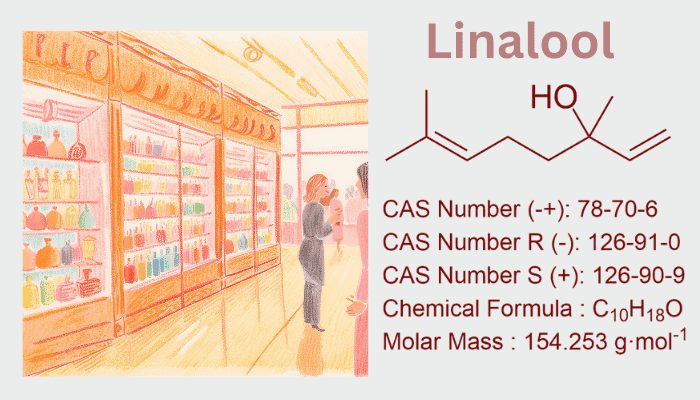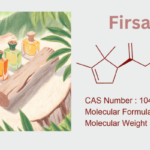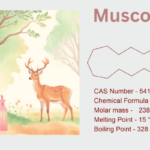1. Introduction: The Ubiquitous Elegance of Linalool
In the fragrance and cosmetics industries, linalool, a monoterpene alcohol with a subtle floral-woody scent, is one of the most adaptable and often utilized compounds. Linalool, which is found in more than 200 plants naturally and has been refined for commercial scalability, combines chemical accuracy with botanical intricacy. It has become essential in cosmetics, fragrance, and other industries because of its capacity to convey the tranquility of green tea, the sweetness of citrus blooms, and the freshness of lavender fields. This article delves deeply into the chemistry, stereochemical subtleties, and industrial uses of linalool, providing an in-depth analysis of why this molecule is still essential to contemporary olfactory artists.
2. Chemical Identity: The Molecular Structure of Linalool
Linalool (C₁₀H₁₈O) is an acyclic monoterpenoid alcohol characterized by:
- A 10-carbon skeleton with a hydroxyl (-OH) group at position 3.
- Two double bonds: Between carbons 1–2 (α-position) and 6–7 (β-position).
- Chirality: A single chiral center at carbon 3, producing two enantiomers: (R)-(-)-linalool (licareol) and (S)-(+)-linalool (coriandrol).
The molecule bridges ephemeral top notes and persistent base accords with its moderate volatility (boiling point: 198–200°C), making it a heart note in perfumes.
3. Stereochemistry: The Olfactory Impact of Chirality
Linalool’s chiral center gives rise to enantiomers with distinct olfactory profiles:
- (R)-(-)-Linalool:
- Aroma: Floral, sweet, reminiscent of lavender and bergamot.
- Natural Prevalence: Dominant in Lavandula angustifolia (lavender) and Citrus aurantium (neroli).
- (S)-(+)-Linalool:
- Aroma: Woody, spicy, with hints of coriander and green tea.
- Natural Prevalence: Abundant in Coriandrum sativum (coriander seeds) and Ocimum basilicum (sweet basil).
Synthetic Challenges:
- Enantioselective Synthesis: For desired scent profiles, catalysts such as Jacobsen’s Mn(III)-salen complexes attain >90% enantiomeric excess (ee).
- Industrial Practice: Most commercial linalool is racemic (50:50 mixture) unless specified for niche applications.
4. Natural Sources: Botanical Origins and Extraction
Linalool is abundant in essential oils, extracted via:
- Steam Distillation:
- Lavender: Yields 25–38% linalool.
- Bergamot: Contains ~30% linalool, prized in citrus perfumes.
- Cold-Pressing:
- Citrus Peels: Bitter orange and lime oils provide fresh, zesty linalool.
- Solvent Extraction:
- Jasmine Absolute: Traces of linalool enhance floral complexity.
Sustainability Concerns:
- Overharvesting: High demand for lavender and bergamot strains ecosystems.
- Synthetic Shift: ~80% of commercial linalool is synthesized to mitigate ecological strain.
5. Synthesis: From Petrochemicals to Green Chemistry
I. Petrochemical Routes
- Dehydration of α-Pinene:
- Process: Pine resin’s α-pinene is isomerized to β-pinene and then pyrolyzed to myrcene. Linalool is then produced by hydrating myrcene with acid catalysts (H₂SO₄).
- Hydrogenation of Citral:
- Citral (from lemongrass) is selectively hydrogenated over palladium catalysts.
II. Biotechnological Synthesis
- Engineered Microbes:
- Through the mevalonate route, Escherichia coli and Saccharomyces cerevisiae that have been altered to carry linalool synthase genes convert glucose into linalool.
- Yield: Up to 2.5 g/L in optimized bioreactors.
- Green Chemistry:
- Enzymatic catalysis (e.g., lipases) replaces toxic solvents, aligning with EU REACH regulations.
6. Uses: Beyond Fragrance
Perfumery
- Heart Note: stabilizes floral (rose) and citrus (bergamot) accords in timeless fragrances like Dior J’adore and Chanel No. 5.
- Fixative: Slows evaporation of top notes (e.g., limonene) in eau de toilettes.
Cosmetics
- Skincare: Antimicrobial properties combat acne in cleansers.
- Haircare: Adds shine and fragrance to sulfate-free shampoos.
Functional Applications
- Insect Repellents: Synergizes with citronellol in mosquito deterrents.
- Flavoring: FDA-approved for candies (e.g., peach gummies) and herbal teas.
7. Perfume Formulation: Crafting Scents with Linalool
Role in Fragrance Families
- Floral: Enhances jasmine and lily-of-the-valley in Gucci Bloom.
- Citrus: Balances bergamot’s sharpness in Acqua di Parma Colonia.
- Oriental: Softens vanilla and amber in YSL Black Opium.
Stabilization Challenges
- Oxidation: Linalool oxidizes to allergenic linalool oxides. Solutions:
- Antioxidants: Tocopherol (vitamin E) or BHT (butylated hydroxytoluene).
- Encapsulation: Cyclodextrins or silica nanoparticles prolong shelf life.
Concentration Guidelines
- Fine Fragrances: 1–5% (e.g., 3% in Jo Malone Lime Basil & Mandarin).
- Body Lotions: 0.1–0.5% (IFRA recommends <1% for leave-on products).
- Candles/Diffusers: 2–8% for sustained aroma diffusion.
8. Percentage in Perfume: Balancing Potency and Safety
Linalool’s versatility comes with regulatory considerations:
- IFRA Guidelines: limited in leave-on cosmetics to 0.1–1.0% because of the potential of sensitization (oxidation to allergic oxides).
- EU Allergen Labeling: If the content in rinse-off products is greater than 0.001% or in leave-on products, it must be disclosed.
Market Trends:
- Clean Beauty: In spite of its natural nature, sensitive skin care brands such as Aesop and Le Labo emphasize “linalool-free” branding.
- Niche Perfumery: Enantiopure (R)-linalool dominates artisanal lavender soliflores.
9. Challenges and Innovations
Sustainability
- Waste Valorization: Citrus peel waste (limonene) repurposed for linalool synthesis.
- Carbon-Neutral Fermentation: Solar-powered yeast bioreactors reduce carbon footprint.
Stereochemical Precision
- Chiral Chromatography: Costly but critical for isolating enantiomers in high-end perfumes.
Future Directions
- AI-Driven Blending: Algorithms predict optimal linalool ratios for target demographics.
- Biodegradable Delivery Systems: Starch-based microcapsules for eco-friendly sustained release.
10. Conclusion: The Timeless Resonance of Linalool
The development of scent chemistry—a dance of nature and innovation—is best exemplified by linalool’s journey from lavender fields to bioreactors. Its dual character as a synthetic workhorse and natural treasure guarantees its continued importance as the industry pursues sustainability and accuracy. “Perfume is the art of making silence speak,” as perfumer Jean-Claude Ellena once said. Linalool continues to express the poetry of scent with its woody echoes and floral whispers.










